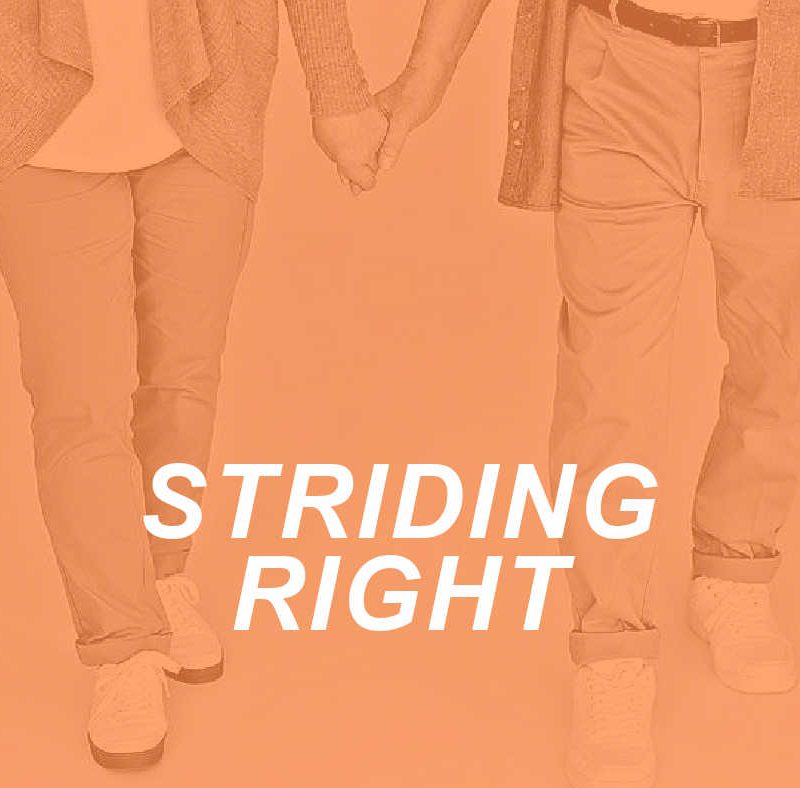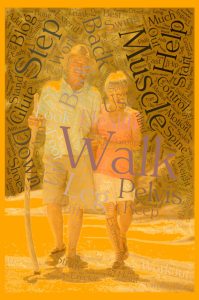
Human strides truly are what made us who we were for Paleolithic hunting and gathering ways and means. Walking and motion still make us who we are in modern days – for better or worse – with our more sedentary ways. What do our older clients want to achieve via their walks in nature? Focusing on optimal striding might help your senior clients achieve their mental and physical health goals.
Striding for Weight Loss
Should weight loss be a client’s motivation, it is a challenge to strike a balance between goal setting and realistic weight loss.
- A marathon distance of ~21 miles covered may burn about one (!) pound of body fat. Over time, those steps do count, but at ~ 10 KCAL a minute – many miles of stepping are needed to expend significant body fat.
Professional trainers and their clients can certainly appreciate the definition of “walk” as an action word to prior generations:
- To go away
- To exercise a dog or horse
- To escort someone
- To move (a heavy object) by turning and shoving it in a manner suggesting walking
- To walk it off, of an injury.
As a subject or noun, “walk” was then:
- A going on foot
- A manner of action, way of living
- In horse racing – the sport of kings – to win in a walk, and most recently
- A walk-a-thon (1963) activity.
As either a verb or noun, walk surely sounds healthy and proactive, when done regularly and safely.
Note that the “10,000 Steps” guidepost for daily strides originated in 1965 by marketers in a Japanese pedometer company.

Walking for Health and Longevity
Improved health and body mechanics are both boons enjoyed by those who engage in regular, purposeful walking. Cardiovascular health is one of the substantial benefits, though not the only merit of gaiting around.
Credible research states that walking as little as 15 minutes a day can add almost two extra years to your life. Walking 30 minutes five times a week can add ~ 3 ½ years to one’s wellness or fitness years.
Another merit, female clients improve their vital bone density with their low-impact strides. Of additional importance is the near-universal ability of most elder athletes to stride, even if suffering from diabetes, arthritis, or respiratory conditions. As a proven platitude of longevity: Motion is good medicine.
Factors Affecting Striding Success
What are the key concepts to employ and share with your senior clients who prioritize walking as a means of regular exercise?
1. Distance or Number of Steps and Gait length
Valid research offers that daily walks of only a few thousand total steps can improve both a client’s longevity and mental wellness. Depending on one’s stride, this threshold for health can be “just” 2-3 total miles covered daily.
An assessment of a client’s gait length is tantamount for at least two reasons:
- Instilling accuracy for “step” applications on a smartwatch or a pedometer which uses gait length to estimate distance traveled.
- Within reasonable ranges of motion, the longer one’s gait – the longer is posterior chain muscular contractions by our gluteals, hamstrings, and calf muscles. Glutes are particularly good metabolic pumps for caloric “burn.”
Overstriding, however, which can be compounded by postural instability and/or improper shoes, can lead to discomfort, inflammation, or injury.
Professional trainers don’t necessarily need to monitor the client’s regular walks or strides. Yet, they should be ever ready to offer improvements in safe walking techniques and equipment options. For instance, observation of the client’s shoe soles may identify over-pronation or supination, both of which can cause kinetic issues and postural dysfunction.
2. Striding Speed
Most client striding about should be done at conversational, or low-intensity pacing. A 70/30 guideline is good for most clients for the ratio of low intensity / capacity-building strides to higher intensity, brisk gaits. About two-thirds of an older client’s striding time per week or month should be at a conversational, capacity-building tempo.
Mayo Clinic guidelines suggest about one-third (30 percent) of a client’s total stride time could and possibly should be done at a brisker pace to challenge cardiovascular, muscle, connective tissues, and joints.
A client may gain about a decade of “fitness age” by decreasing their walking time by 90 seconds for a 1.5-mile distance. That is quite an incentive to cover ground rapidly!
3. Attention to Footwear and Mobility
Plantar Fasciitis is a fairly common, enduring, and uncomfortable condition. If a client mentions heel or mid-foot discomfort that persists more than a few days and does not respond to self-myofascial release and stretching, refer your client to a medical provider. Performing a functional gait assessment can assist a trainer to note issues and muscle imbalances that need attention (further explored in a follow-up article).
Proper striding shoes are imperative for safe and enjoyable gaits. As cost may be a factor for some clients, a trainer may be able to suggest shoes that meet needs and price points. Light and flexible shoes are usually recommended over thicker, pillowy shoes for overall fitness and injury prevention, but guiding foot strength is incumbent upon the trainer to build as a foundation. Orthotic supports may compensate for leg length differences or minor foot/heel pains, but this is best assessed by a medical professional as well.
Dynamic stretches before striding, and 20-30 second static stretches after a good stroll are recommended for major muscle groups.
*Note: Walking barefoot for extended periods or distances may not be fruitful for some older clients of medium or heavy body weight. Elders’ feet, usually with deconditioned muscles and flatter arches can precipitate foot discomfort when barefooted for too long.
A client should consider shoe replacement if emergent heel, knee, or hip discomfort emerges, and/or about 500 miles were covered in that pair.
4. Safety
Simple reminders for a client’s accident and injury prevention while striding include:
- Watch out for the other “guy”
- Two earbuds or a smartphone may become safety distractions – either on the client or on others in proximity.
- When possible, select level, softer surfaces for striding. Flat grass is preferable to asphalt. Asphalt is preferable to concrete. Concrete is preferable to sloping beach sand – unless you are in Navy BUDS training.
- Carefully consider temperature and weather before and during a walk. Things can change quickly in many locales.
- Reflective articles and fairly bright, visible clothing articles are strongly encouraged. Be Safe!
5. Fitness Applications or Devices
Such applications or tracker tools won’t do the work for your client but can serve as extra motivation.
Wearing a Fitbit or checking a smartphone application won’t make a client walk more, but it could help to keep striding right. It depends on factors like digital savvy, price points, and their readability while in motion. As always, professional trainers should be mindful of clients’ affinity for digital technology. If a digital device helps a client plan the execution, then execute and record what was planned for a walk, then a device may well be a solid investment. Log-keeping by any means has true merit.
Old fashioned walking plans are often a sustaining program element.
Safe Striding Summary
Walking or striding (with an effective gait) is an excellent, safe exercise for most of a client’s body and all of her or his mental capacities. However, vigilance is needed for safety while striding – either outdoors or on a treadmill! Striding to build stamina may be the best exercise to promote neuroplasticity, and as such, should be highly encouraged for all of our clients, but especially seniors.
Motion is Medicine for a client’s long and successful journey!






